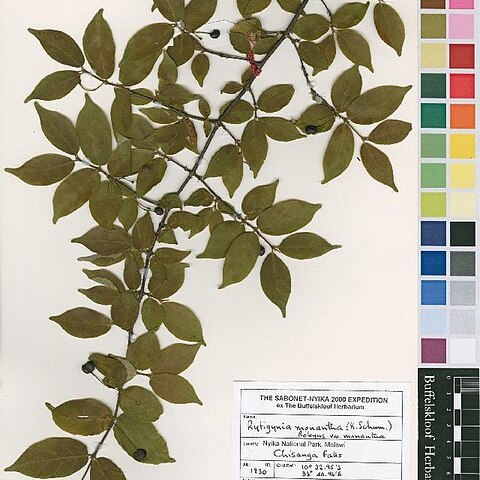Leaves 1–6 × 0.5–4 cm, ovate, oblong or elliptic, narrowly acuminate at the apex, rounded to cuneate or sometimes subcordate at the base, typically markedly discolorous with a dense appressed yellowish or whitish pubescence above and a dense ± coarsely velvety pubescence beneath, the pubescence not entirely obscuring the ± reticulate venation, or sometimes the indumentum is much sparser and some Malawi specimens have almost glabrous leaves; petiole 1–4 mm long; stipules with the hairy basal hyaline parts joined to form a sheath 1.5–2 mm long; stipule appendages compressed, 3–10 mm long, lanceolate or narrowly falcate, drying dark, or rarely the appendages pale and filiform.
Corolla clavate, acuminate, apiculate or with 5 distinct tails in bud, but very variable and sometimes (in Rwanda) ± blunt; white, pale yellow or greenish, usually spreading bristly pubescent but occasionally glabrous; tube 3–6 mm long, ± glabrous inside, with few deflexed hairs outside or pubescent in upper half; lobes 2–4 × 1–2 mm, triangular to lanceolate, acute, with an apiculus or short appendage 0.5–1.5 mm long, often creamy-white inside, usually bristly pubescent outside or less often glabrous (particularly in Malawi material).
Much branched shrub or small tree 0.3–4.5 m tall; older stems brown, purple-brown or reddish, the bark very finely fissured smooth, or sometimes in exposed areas becoming rough and nodose, the dark very rough bark flaking to reveal a reddish or pale brownish powder; branching often ± horizontal; young shoots green in life, densely shortly spreading pubescent with sometimes bright rusty hairs, or in some areas (e.g. Malawi) ± glabrous.
Style white, usually exserted 1–3 mm, sometimes with few hairs just beneath the pollen presenter, ± dilated at base; pollen presenter whitish, 1 mm long, depressed subglobose or oblong-obconic, sulcate beneath, 3–4 lobed at apex.
Calyx tube 1–1.5 mm long, densely pubescent outside, densely hairy inside all over; lobes 5–8, 0.5–1.5 mm long, linear to triangular, (long and linear in Malawi).
Inflorescences 1–2-flowered; peduncle 4–16 mm long; pedicels (2)3–9 mm long, lengthening to 19 mm in fruit; bracts ± connate, 1.5–3.5 mm long, ovate, acuminate.
Fruit 6–8 × 7–8 mm, subglobose, pubescent, with 1–4 pyrenes.
Ovary 3–4-locular.


